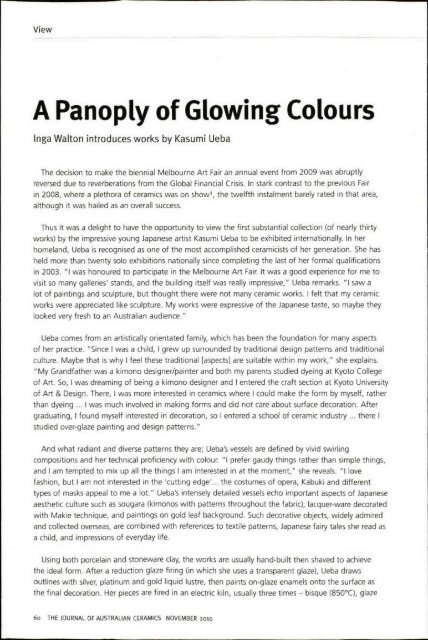The Journal of Australian Ceramics Vol 49 No 3 November 2010
You also want an ePaper? Increase the reach of your titles
YUMPU automatically turns print PDFs into web optimized ePapers that Google loves.
Penaga Leaf showing detail <strong>of</strong> smaller granite leaves<br />
Photo: Glenn Romanis<br />
left to right: Angela Kasturi. Helen Bodycomb, Glenn<br />
Romanis, Hijjas Kasturi and Dominic Johns on the last day<br />
<strong>of</strong> work; photo: Dominic Johns<br />
Concept as written by George Fishman<br />
<strong>The</strong> Shyness <strong>of</strong> Trees refers to a phenomenon <strong>of</strong> the rainforest canopy in which abrasion <strong>of</strong> the<br />
growing tips <strong>of</strong> individual trees (and possibly the actions <strong>of</strong> insects) "prune" the trees and prevent<br />
hostile interaction among neighbouring trees. This action causes a visual effect in which an observer<br />
looking up in the forest may see 'rivers' <strong>of</strong> light streaming through those gaps separating the trees. It<br />
was this negative space the artists incorporated in their composition. Also included in the composition is<br />
an illusory portal that reflects the actual door at the opposite end <strong>of</strong> the passageway and suggests travel<br />
through place and time, discovery and awakening.<br />
<strong>The</strong> blue and white discs scattered throughout the composition are the decorative centres <strong>of</strong> Chinese<br />
bowls, salvaged from a 17th century shipwreck <strong>of</strong>f Vietnam. <strong>The</strong>y also represent the coins purportedly<br />
shot into the forest by British Captain Francis Light at the beginning <strong>of</strong> Penang's colonial period to<br />
encourage Malay residents to clear the land. Additionally, an array <strong>of</strong> narrow chromatic gradient strips<br />
in a vivid palette <strong>of</strong> glass suggests prismatic light effects within the moist air <strong>of</strong> the rainforest. Both<br />
elements reflect the geometry and colou r <strong>of</strong> the large stained glass roundels on the flanking wall, part<br />
<strong>of</strong> the architectural design scheme provided to the artists. <strong>The</strong> wall mosaic spills onto the archway, side<br />
walls and ceiling engaging the surrounding architecture.<br />
Activating the long granite pavement <strong>of</strong> the passageway, a meandering course <strong>of</strong> engraved lines<br />
conjures the Penaga River, now lost to development. It connects the wall and floor elements, creating<br />
an ambiguous continuity, as the 'water' becomes 'air' and 'light' when it encounters the wall. <strong>The</strong> floor<br />
also contains a large mosaic Penaga leaf insert, made up <strong>of</strong> smaller stone leaflets. <strong>The</strong> Penaga tree,<br />
once prevalent, was said to have stained the river red. It is now quite rare in George Town, but has been<br />
included in the owners' landscaping plan.<br />
We made the work using the direct on mesh method, which involves glueing the mosaic material<br />
onto a fibreglass mesh. Under the mesh is a clear plastic sheet that protects the cartoon (design)<br />
underneath. We used a two-part cementitious adhesive (made by Mapei), which consisted <strong>of</strong> Kerabond<br />
Plus (cement adhesive) mixed with Isolastic (latex liquid). <strong>The</strong> cartoon was divided into several large<br />
s8 THE JOURNAL OF AUSTRALIAN CERAMICS NOVEMBER <strong>2010</strong>


















